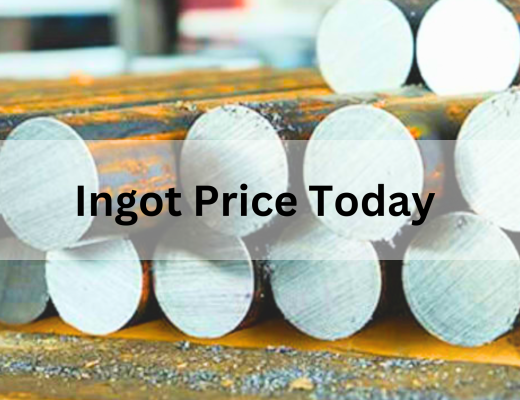The debate associated with the fluctuating price of steel is incessant. In the construction industry of India, steel plays a crucial role. Since it is one of the major contributing raw material, an increase or decrease in its price will drastically impact the construction cost.
In recent years, the consumption of stainless steel in India has been half the consumption of the whole world, so the stainless steel price in India is higher than before.
Steel steers the 21st-century Indian economy by $64 trillion in the forward direction. It also pitches in almost 2% of the Gross domestic product (GDP). Considering employment opportunities, this industry in India employs around five lakhs and 20 lakhs, directly and indirectly, respectively.
With the modern steel industry in India embracing more innovations, producing premium quality steel ensures better results. But an increased production of steel indicates an upward shift toward its consumption. Despite the increase in production in India, there’s still a demand-supply gap. And with the rise in prices, nickel and chromium costs also witness a surge.
Wondering what are the parameters that affect the steel price? If yes, let’s navigate the fluctuating prices here in this post.
India’s Competitive Steel Industry: What Might Be the Reason behind Steel Price Fluctuation?
Compared to the metal prices in international sectors, steel prices in India are competitive. The price keeps fluctuating because of the global steel prices in India trends. Market dynamics play a crucial role in influencing the price of this deregulated domain.
The coal prices are increasing, and so are the expenses of raw materials. So, amidst this competitive market, selling steel at a cost-effective rate becomes impossible for suppliers.
Considering the worldwide manufacturers, China is the biggest steel producer, manufacturing more than 55% of the world’s steel. Ever since July 2020 (after the pandemic outbreak), the prices have increased since China implemented fundamental decisions concerning the supply and export of this raw material. Ever since then, steel rates have escalated worldwide and doubled within a short timeframe. Wondering which parameters influence the price increase? Let’s dive into the pointers to learn better:
A Dearth of Raw Materials
A rise in the steel price increased iron ore cost, which is the basic component of steel. The most significant iron ore manufacturers (like Canada, Brazil, and Australia) have limited production after the pandemic outbreak.
Thus, the low supply and rise in demand have contributed to a surge in the price of iron ore. Another reason can be a dearth of other raw materials that increases the demand for steel, thereby raising the cost.
China’s Massive Decisions
Decisions made by China contribute to a change in steel prices in India. Learn more from the following points:
- Limiting Export
With the intention to decrease production and meet domestic requirements, China reduced exporting steel to other nations. It caused a massive price hike while disturbing the economy.
- Restricting the Manufacturing
To reduce pollution, China reduced the production of steel. Although it reduced the carbon emissions in polluted cities like Tangshan, it increased the steel price.
- Suspending the Rebate Relaxation on the Taxes
With China removing the rebate relaxation on value-added tax, it contributed to an increase in the price figure. After the nation suspended rebate relaxations on taxes, steel prices increased.
- Importing from India
After China, India is the largest steel producer. To fulfil the domestic requirements, China imported raw materials from the country, which increased the price.
An Increase in the Demand for Steel
With the economic activities being resumed after the lockdown, increased demand for core materials was noticeable. But the production of steel didn’t accelerate, which resulted in a price hike.
A Slow Production Pace
After the COVID-19 pandemic outbreak, there’s been a rise in the demand for steel. This made budding steel producers increase their production to suit their needs. But this gave rise to sluggish production, which ultimately increased the price.
Limited Production
As already discussed, China is the largest exporter and producer of steel, with 60% of the steel supply in the world. It witnessed a reduction in the local markets owing to production curbs, which led to a 5 to 7% rise in the price.
Worldwide commodity price stagflation
The resource sector was affected worldwide due to the following reasons:
- Cartelisation by local suppliers in significant markets
- An interruption in the regional trade agreements
- With higher inflation rates, most developing economies had to deal with stagflationary pressures
Disturbances Owing to Global Conflicts
Ukraine’s war affected the interconnected supply chains, with the cost of raw materials increasing exponentially. But later on, the supply-demand dynamics settled the prices gradually.
Can You Save Money When Buying Steel?
Implementing the following strategies help contractors save money while buying steel from the market:
- One must anticipate the steel requirements first
- It is advisable to lock in prices before they further increase
- Comparing prices from various suppliers ensures getting the best deal
- Choose the right platform to obtain mastery insights into the essence of cost drivers, including raw material, profit, overhead, and more
[Note that the platform should help achieve optimum expense while analysing expenditure and identifying opportunities for cost rationalisation]
- Evaluating the feasibility of using salvaged or recycled steel (that is a cost-effective option)
- Checking out the recent market trends to stay well-informed about the steel market, its supply chain dynamics, and price fluctuations
Why Choose Raw Material Price Tracking?
If you are in the construction industry, you must learn about the fluctuating steel prices chart in India. That makes it evident to choose a raw material price tracking service. Choose a service provider that offers the following:
- Monthly CIR report in the PDF format
- Access to the digital RM price data with a personalised range
- Commodity price forecasting offers quarterly PDF reports of more than 40 commodities
If you want to get these reports, contact us today. You can consult us to track the steel price Index in India. At CostMasters, we bring the best-in-class raw material tracking solutions with a reliable database and reasonable pricing.


